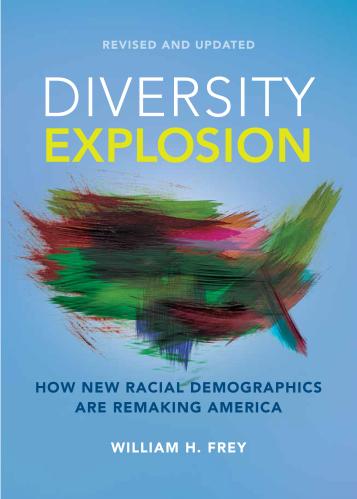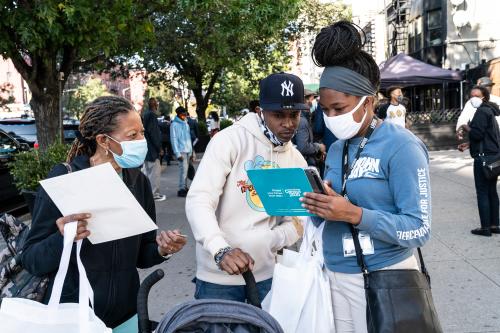Contents
- The late 2010s saw white population losses and racial minority gains
- The roles of natural decrease, natural increase, and immigration
- People of color are becoming more prevalent among the young.
- The 2020 census and America’s demographic destiny
As we await the final 2020 census statistics for America’s race and ethnic populations (due later this summer), newly released Census Bureau estimates compiled independently of the 2020 census1 suggest something unprecedented: The 2010s could be the first decade when the nation’s white population registered an absolute loss.
These new estimates show annual population changes by race and ethnicity between July 2010 and July 2020. They indicate that, for each year since 2016, the nation’s white population dropped in size. Thus, all of U.S. population growth from 2016 to 2020 comes from gains in people of color.
These statistics extend and update a trend revealed in data published last year, and further emphasize why the diversity profile of the U.S. population is rising rapidly. This is especially the case for the nation’s younger population, which experienced the greatest white population losses. The statistics also imply that, as the white population ages and declines further, racial and ethnic diversity will be the hallmark demographic feature of America’s younger generations, including Gen Z and those that follow.
The late 2010s saw white population losses and racial minority gains
Earlier population estimates have shown that the 2010s decade—especially its later years—was one of historically low population growth. This was the result of declining fertility, increased mortality, and a slowdown in immigration from abroad. The former two trends are especially characteristic of the nation’s white population, who are aging more rapidly than other groups.2
As Figure 1 shows, annual white population losses over the four years between 2016-17 and 2019-20 were 129,000; 252,000; 290,000; and 482,000. Together, this loss of more than 1 million white people outweighs the white population gains of the decade’s six earlier years, leading to a likely first-ever decade decline of the nation’s white population when the final 2020 census results are tallied (Download Table A).

In contrast, nonwhite race and ethnic groups increased in size over each year of the decade, and were responsible for all of the nation’s population growth between 2016 and 2020. Latino or Hispanic Americans led all groups, with annual gains at or approaching 1 million a year. Asian Americans added between 300,000 to over 500,000 to their population each year, followed by Black Americans, persons identifying as two or more races, and American Indians and Alaska Natives.
Like the population as a whole, the positive gains for each of these groups dropped off somewhat in recent years. Even so, the large growth for people of color, as a group, reduced the white share of the total population from 63.8% to 59.7% between July 2010 and July 2020. The 2020 census is likely to show, for the first time, that more than four in 10 Americans identify with groups of color.

On a state level, 30 states lost white population over the 2016-2020 period (Download Table B). The greatest losses were registered by California, New York, Illinois, Pennsylvania, and New Jersey, where white out-migration accentuated the decline. Among the 20 states that gained white population over this period were those in growing parts of the South and West, including Florida, Arizona, North Carolina, South Carolina, Utah, Colorado, Tennessee, Texas, and Idaho.
In contrast, all states except one (Hawaii) exhibited 2016-to-2020 gains for their combined populations of color. This helped to reduce or counter overall losses in states that registered white population declines. Among the 30 states that lost white population over this period, 18 reported overall gains. For example, California’s loss of 631,000 white residents was more than countered by gains of 850,000 people of color.
The roles of natural decrease, natural increase, and immigration
The relative sizes in the numbers of births and deaths for different race and ethnic groups accounts for some of the difference in their respective population gains. Figure 3 shows how these different groups fared in the size of natural increase (defined as the number of births minus the number of deaths) over the first nine years of the last decade.


Here, the white population stands out due to its negative value on this measure—meaning it experienced more deaths than birth, or natural decrease (Download Table C). This reflects, in part, the white population’s older age structure compared to other groups, leading to more deaths and fewer births. The latter is due to a proportionately smaller share of its population in childbearing ages as well as lower actual fertility rates among white women compared to the rest of the population.
The other demographic component that favors nonwhite over white groups is immigration. Over the 2010-to-2019 period, Latino or Hispanic and Asian groups registered substantially higher levels of immigration than white people, contributing to their overall growth. Still, it should be noted that among all nonwhite groups except Asian Americans, immigration contributes less to their growth than natural increase. Among Latino or Hispanic people, gains from natural increase were more than three times those of immigration.
Levels of immigration and natural increase were lower overall in the decade’s last four years than was the case earlier due to more restrictive immigration, lower fertility, and a rise in the number of deaths, especially as the COVID-19 pandemic took hold. These factors contributed to increasingly smaller gains for each nonwhite group and greater white population losses. Still, particularly in these later years, the nation was dependent on people of color, especially Latino and Hispanic and Asian Americans, for their contributions to overall population growth.
People of color are becoming more prevalent among the young.
Focusing on 2016 to 2020—the period when white population loss began to emerge—it is useful to examine the nation’s racial and ethnic demographic change across broad age groups.

Figure 4 shows that white population loss over this period is heavily skewed among the nation’s younger and prime labor force ages (under age 25 and ages 25 to 59). This has to do with the continued aging of the baby boomer population into oldest category (age 60 and over). In fact, the ascension of white baby boomers into the 60-plus age group is largely responsible for that category garnering the lion’s share of the nation’s population gain during this period (Download Table D).
In contrast, the two younger age categories experienced white population losses. In fact, the under-25 age group registered an overall population decline because white losses were not countered by people of color gains. (Within the people of color category, there were also small losses among African Americans, American Indians, and Alaska Natives.) The 25-to-59 age group did show a population gain during this period, but only because the combined people of color gains were larger than white losses.
The different age structures of each group underlie this dynamic. All groups of color have lower median ages than white Americans—reflecting, for some, recent immigrant waves who, with their children, help the groups maintain a younger age profile. And, as discussed above, white Americans’ older age profile led to the group exhibiting a natural decrease. It is also the case that as mixed race couples continue to increase, their children will identify with the “two or more races” category.


For these reasons, younger age groups are experiencing the greatest rise in diversity. The new estimates show that between 2010 and 2020, the white share of the under-18 child population will drop from 53.7% to 49.6% (see Figure 5). The 2020 census could be the first to show that more than half of America’s children identify as people of color.
This will also accentuate generational differences in race-ethnic profiles. Again using the census estimates, generations will range from less than 30% people of color (for baby boomers and their elders) to people of color shares of 45.1%, 48.7%, and 51.3% among millennials, Gen Z, and post-Gen Z, respectively (see Figure 6).
The 2020 census and America’s demographic destiny
As I have written in my book “Diversity Explosion”, there is no doubt that racial and ethnic diversity is poised to play an important role in contributing to the nation’s demographic and economic well-being. It is already apparent from these new population estimates that different groups of color have been and will continue to be responsible for maintaining growth in America’s overall population. This is especially the case for its youth and young labor force population, who represent the nation’s future.
Moreover, the small loss in the white population need not be viewed in a negative light. As younger generations representing all racial and ethnic backgrounds come to grow and interact with each other, sharp racial lines between white, Latino or Hispanic, Black, Asian American, and other groups should begin to dissipate, at least from a demographic perspective. Already in 2015, nearly one in six new marriages were mixed race—a factor that will lead to even larger numbers of people who identify with more than one racial and cultural origin.
The soon-to-be-released 2020 census will make even more clear where the nation’s demographic destiny resides—once again illustrating a patchwork of different races, backgrounds, and cultures that are dispersing across all parts of the country.
-
Footnotes
- These estimates are produced by the Census Bureau’s population estimates program and use a methodology that updates 2010 census numbers with information on housing and other demographic components compiled annually over the course of the decade. The 2020 census numbers, yet to be released, will differ from the 2020 size estimates shown. The Census Bureau produced these annual “evaluation estimates” for research purposes, and they are used here to provide an assessment of annual race-ethnic change for the U.S. and states over the 2010-2020 decade.
- Here and elsewhere, the “white population” pertain to white persons who do not also identify as Latino or Hispanic or other race and ethnic groups.







